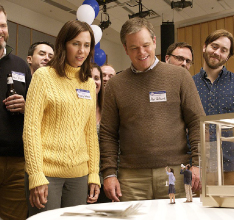When I saw the trailer for Alexander Payne’s new film, Downsizing, I thought the movie would be a light-hearted farce, relying principally on visual gags. In point of fact, the jokes based on the contrast between regular-size people and their five-inch tall counterparts are surprisingly rare. Most of the film deals with events within the world of the downsized—so everything seems more or less normal. And when I took in the opening scenes, and heard a lot of talk about protecting the environment and the dangers of overpopulation, I thought that Downsizing would be a propaganda piece for left-wing causes. Here I was surprised again, for the film amounts, I will argue, to a not-so-subtle critique of that ideology.
Downsizing opens in a Norwegian lab where a group of scientists are testing an experimental technique to reduce animals in size. It soon becomes clear that the purpose of these endeavors is to apply the technology to human beings. The most dramatic scene in the film is the moment when the team presents a five-inch person to a lecture hall of astounded researchers and journalists. We then flash forward several years to discover that downsizing has become a popular trend, though the majority of people undergo the procedure for financial rather than piously environmental reasons. It appears that the dollar goes much further when you have tiny clothes, your nutritional needs are those of a mouse, and you live in a doll house.
At this point, we meet Paul Safranek (played by a rather pudgy-looking Matt Damon) and his wife Audrey (Kristen Wiig in a surprisingly sober turn), who have decided to take the plunge. But on the fateful day, Paul goes through with it, while Audrey chickens out, leaving Paul stranded in the land of the tiny. Compelled by his wife’s treachery to divorce, Paul finds himself out of his mansion and stuck in a nowhere-job and a small apartment. Just as he hits bottom (literally lying in a stupor on the floor of a friend’s apartment after a night of debauchery), he spies Ngoc Lan Tran (wonderfully incarnated by Hong Chau), a noble Vietnamese activist who had been forcibly downsized by her government and who now does menial labor, cleaning the homes of the wealthy. Despite the loss of a leg, Ngoc has devoted herself, in her spare time, to the care of an army of the underclass of the small, who live in a sprawling slum. When she discovers that Paul has some basic medical training, she presses him into service, bringing him to suffering person after suffering person, compelling him to come out of himself. Carrying a Bible and attending enthusiastic religious services, Ngoc is unembarrassedly a Christian, and it is unmistakable that her faith informs her dedication to those in need.
By an odd plot twist (I won’t bore you with the details), Paul and Ngoc travel to Norway to commune with Dr. Jorgen Asbjørnsen, the scientist who developed the downsizing technology, and the original commune of the small, who are living like a band of hippies along the shores of a picturesque fjord. They soon discover that this community, convinced that environmental pollution will render the surface of the earth uninhabitable, has actually resolved to retreat to a subterranean world that they have constructed. Beguiled by their romanticism and dedication, Paul decides to go with the community and he leaves the tearful Ngoc behind. But then, just as the entrance to the tunnel is about to be blown permanently shut, Paul races out and embraces his beloved. The two of them then return to the States and Paul gives himself over to Ngoc’s work of service for the suffering poor.
A film of social commentary? You bet, but not the social commentary I was expecting. Is there a better symbol for the downsizing that is currently happening in Europe than the shrinking and disappearance of that original colony of the small? For the past roughly fifty years, the West in general, but Europe in particular, has been experiencing a population implosion, the number of births way below replacement level in England, France, Holland, and Germany. This has been prompted, of course, by a number of factors, but certainly one of them is a conviction that human beings are just bad for the planet, using up too many resources, raping the environment, etc. Wouldn’t it be best, many seem to think, if the human race just shrank down and went away? Downsizing gives dramatic expression to this conviction and, not so subtly, makes fun of it. I laughed out loud when, at the climactic moment of Paul’s escape, the camera pulls back and reveals the “blowing” of the door as a tiny pebble falling about two inches to the ground. Talk about going out, not with a bang, but with a whimper.
Contrasted to this despairing retreat is the vibrant compassion exemplified by Ngoc. She too sees the world as a painful place, but her resolution is not to retreat but to address the pain through love. And it cannot be accidental that the Vietnamese woman’s Christian faith is clearly emphasized, while no one on the European side exhibits the slightest interest in religion. In point of fact, it is precisely religious faith that will awaken courage and compassion, and it is precisely the lack of faith that conduces, by a short road, to spiritual and psychological exhaustion—both in the individual and in a culture.
I applaud Downsizing for making this contrast clear.
